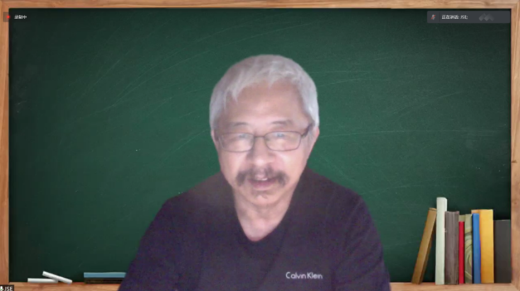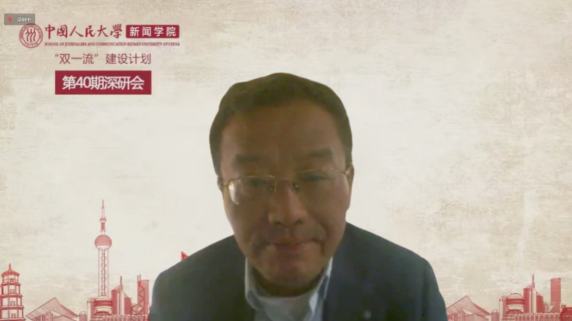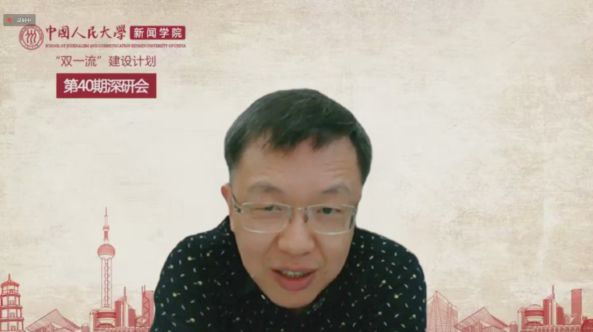The School of Journalism and Communication and the Research Center of Journalism and Social Development of Renmin University of China co-hosted the 40th symposiumtheming “Interdisciplinary Dialogue in Intercultural Communication: Whether and How Intercultural Communication is Possible” on October 30th.
The symposium aimed to discuss intercultural communication from a multidisciplinary perspective and to improve international communication theory research in China. Experts and scholars from philosophy, journalism and communication, sociology and other fields discussed the frontier issues and development prospects of intercultural communication from different disciplinary perspectives.
Zhou Yong, Executive Dean of the SJC, said the symposium aimed to bring together experts and scholars to discuss issues in journalism and communication in a multi-perspective and interdisciplinary way. Zhou pointed out that intercultural communication studies need to propose new ideas for China's international communication and discourse construction in the context of profound changes in globalization. Zhou also said that in the face of the development of the times and changes in the international community, the field of journalism and communication should draw inspiration and strength from interdisciplinary dialogue and contribute its own wisdom to the construction of China’s international communication.

Lin Shengdong, professor of theSJCargued that the problem of intercultural communication cannot be solved by a single discipline, but requires multidisciplinary concerns. Lin also said that journalism and communication needs to expand its vision and endow itself with new imagination through interdisciplinarycollaboration.
Ju Shier, director of the Institute of Logic and Cognition of Zhongshan University, explored the existence of universal knowledge and shared knowledge, and presupposed that the two types of knowledge do not exist, then proposed the theory of mutual adaptation of intercultural interactions. According to this theory, the two parties of intercultural communication are in different environments, but they can achieve mutual adaptation through dynamic interaction, which means approaching a satisfadctory position based on their respective needs.

Wang Defeng, professor of the Department of Philosophy of Fudan University, gave a report entitled “Language Distortion and Correction in Intercultural Communication”. He said that the essential differences between different cultures cannot be erased, and language is the living context of a nation. In his opinion, intercultural translation must bring some degree of distortion. Positive distortion means that the thoughts and feelings of one nation are inspired by another nation, while negative distortion means that the text is wrongly interpreted to smooth out cultural differences. Taking the Sinicization of Buddhism and Marxist theory as examples, Wang pointed out that it is necessary to distinguish the overlapping parts in the living contexts of different nations and form mutual inspiration and symbiosis of cultures under the difference in order to correct the negative distortion.

With the theme of “The Problem Domain of Intercultural Communication Research”, Shan Bo, professor of the School of Journalism and Communication of Wuhan University, sorted out the following frameworks from different disciplinary fields' concerns about intercultural communication: the uncertainty of interaction between subjects, the otherization of contact between groups, the difference of communication between languages, and the power domination of culture. He pointed out that people in intercultural conflict seek a dynamic balance of anxiety and non-anxiety, certainty and non-certainty, and that this dynamic process foreshadows the possibilities of intercultural communication. In response to the problems of linguistic differentiation and cultural power domination, Shan argued that respecting discursive power is the ultimate way of linguistic communication, and only through continuous intercultural interaction can we gradually acquire an integrated cultural perspective and thus escape from self-alienation. Finally, Shan pointed out that the advent of 5G offers new prospects for intercultural communication in terms of contextual communication, relation communication and emotional communication.

Zhai Xuewei, professor of the Department of Sociology of Nanjing University, discussed the topic of “Relational Orientation: From Cultural Interpretation to Theory Construction”. He first discussed localization of social science, briefly introduced several important views that exist in the academy and pointed out their shortcomings. According to Zhai, it is undesirable to rely on and transplant western theoretical resources to explain local cultures since different types of cultures require different theoretical constructions. He shared his practice of extracting two dimensions of “temporality” and “spatiality” from Chinese local culture, and re-distinguishing the characteristics of the relationship between Chinese and Western cultures from the four relational dimensions combined in them.

Roger T. Ames, chair professor of the Department of Philosophy of Peking University, talked about “Chinese Philosophy and Its Interpretive Context”. The theme of his speech is how to make traditional Confucian culture speak its language. He argued that during the recent cultural encounter between China and the West, many Chinese concepts have been interpreted within the framework of Western philosophy but have been distorted, producing a “profound asymmetry in making cultural comparisons”. According to Ames, if we want to explain a cultural phenomenon clearly, then it is necessary to deeply understand and be immersed into that cultural tradition. He also discussed the question of what is “human” from the perspective of Confucianism's role ethics.

Lin shared the theme of “Harmony in Diversity: A Content Theory Construction Based on Intercultural Communication Practice”, explaining and refining what is the ideal goal, namely “Harmony in Diversity”, of intercultural communication through vivid examples, and he explained the realistic basis of this goal from the pyramidal level of cultural contact. Lin combined his own experience and successful intercultural communication practice to give an in-depth interpretation of this topic. He also took the success of Li Ziqi's video overseas as an example to show the possibilities and problems of combining form theory and content theory.

In the discussion session, six professors and the online participants shared their views on “What is the role of communication in intercultural communication”, “Is there universalism in intercultural communication and interaction?” etc. At the end, Lin expressed his gratitude to the teachers, students and staff.
Author: Li Nan, Yang Hao, Wu Zhe
Photo by: Li Nan, Yang Hao, Wu Zhe
Translator: Wang Xi
Editor: Xu Yiwen,Wang Daosheng



